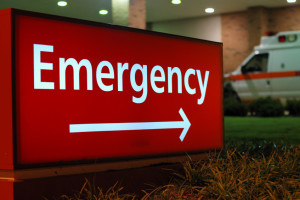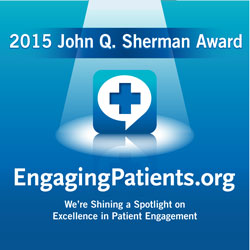Patient-centered care. Family-centered care. Relationship-based care. I see these terms used freely around the Internet and blogosphere. I suspect they mean different things to different people, but as a patient advocate, I think they merit serious discussion. In shifting from a task-based approach to more a patient- and family-centered model of care that seeks to develop a relationship with patients, I believe there’s a significant opportunity to transform the patient experience and even impact outcomes.
 I need only look to a recent emergency run to the hospital with my spouse who deals with several complex, chronic conditions. Alone, anxious and uncertain, I was buoyed by people who were keenly tuned into my needs. I’ll be the first to admit that I’m an expressive person whose face typically signals my state of mind, but I credit the hospital staff with listening to me attentively and responding in ways I never expected.
I need only look to a recent emergency run to the hospital with my spouse who deals with several complex, chronic conditions. Alone, anxious and uncertain, I was buoyed by people who were keenly tuned into my needs. I’ll be the first to admit that I’m an expressive person whose face typically signals my state of mind, but I credit the hospital staff with listening to me attentively and responding in ways I never expected.
Support came from most everyone I encountered, far exceeding my expectations. My most memorable encounters were with:
The Transporter – When my spouse was admitted for observation, a young man transported him to the nursing floor. As we approached the designated room, I saw that it wasn’t a private room but occupied by a woman who was in obvious pain. I expressed my disappointment and concern to “Mike” who kindly told me that I could request a private room as there were several open rooms. He pointed to the person at the nurse’s station who could help but when he saw my reticence to speak up, he stepped in and said, “Let me be your advocate.” We got our private room.
The Housekeeper – With my husband settled in his room, I went in search of coffee. Not the machine variety which our nurse had graciously offered to get me, but a stronger, barista-style cup of Joe. However, when I asked the housekeeper how to find the café, it became quickly apparent that I was both directionally-challenged and stressed. In her kindness, she set aside her work and escorted me two floors down and to the café at the opposite end of the building.
The Hospitalist –After a battery of tests, we determined there had been no stroke, no heart attack, no sign of arrhythmia. Great, but we still had no definitive answer! I had shared my observations with the ED staff the night before, but apparently the details weren’t passed along to the hospitalist. Gratefully, the hospitalist was kind and respectful, reviewing initial findings and asking for my thoughts and observations. No arrogance or defensiveness. Together, we were able to arrive at the likely diagnosis, diabetic shock. I felt empowered and relieved, knowing I could make a difference by playing a more active role.
The RN – With my husband discharged, a volunteer wheeled him down to the
hospital entry while I pulled up the car. Getting out of the car I thanked him, insisting I could get my husband into the car. However, that proved to be a more challenging job than I anticipated. Unsteady on his feet and carrying a “portable” oxygen tank, my 230-pound husband and I must have presented a frightening sight. Talk about fall risks! Out of nowhere, a nurse rushed to our rescue and we safely transferred him into the car. I didn’t see her name, only the “RN” on her badge. I thanked her and she was gone as fast as she arrived.
Doing It Right
It’s great to find people “doing it right,” but I know this is not something that happens by chance. When I hear stories such as those from Randi Oster, Nicole Donoghue or Barbara Lewis, I know it must take a commitment from the top to reshape what is essentially a task-driven culture in most hospitals. It means taking time to listen to patient and family stories and inviting them to co-design the care experience. Moreover, it means changing protocols and empowering clinicians and staff to go beyond the scope of their job description to put patients and families first.
It’s a daunting challenge that has to be addressed unit by unit, knowing that the model of care will need to be different in the ED, Maternity, the Cardiac unit, etc. However, I’m encouraged by the practice models I see emerging, such as that followed by the Cleveland Clinic, and the tools being developed like the Doctella Passport for Patients.
I believe there will be a payoff for those healthcare systems that adopt a patient- and family-centered approach to care – improved outcomes and HCAHPS, and stronger relationships with patients whose loyalty will cross generations and extend to their personal networks. And I also suspect that a relationship-based model of care will enhance job satisfaction for clinicians and staff as well.
Spotlighting Excellence
 Right now, the EngagingPatients community is looking for those examples of successful patient and family-centered care. We want to showcase the initiatives that are improving care and outcomes through patient and family engagement. That’s why we created the John Q. Sherman Award for Excellence in Patient Engagement. You can learn more about the award and download the nomination form at www.engagingpatients.org/awardsubmissions. Then nominate by February 28.
Right now, the EngagingPatients community is looking for those examples of successful patient and family-centered care. We want to showcase the initiatives that are improving care and outcomes through patient and family engagement. That’s why we created the John Q. Sherman Award for Excellence in Patient Engagement. You can learn more about the award and download the nomination form at www.engagingpatients.org/awardsubmissions. Then nominate by February 28.
Let’s celebrate and share the best practices!




